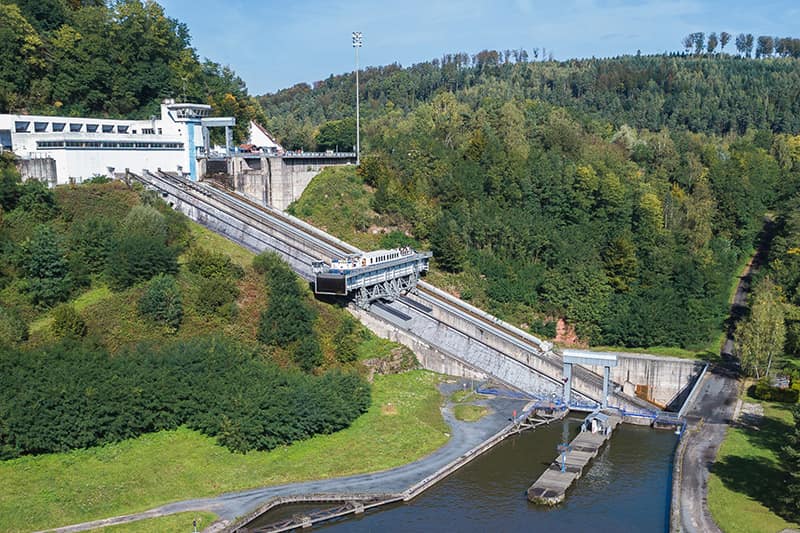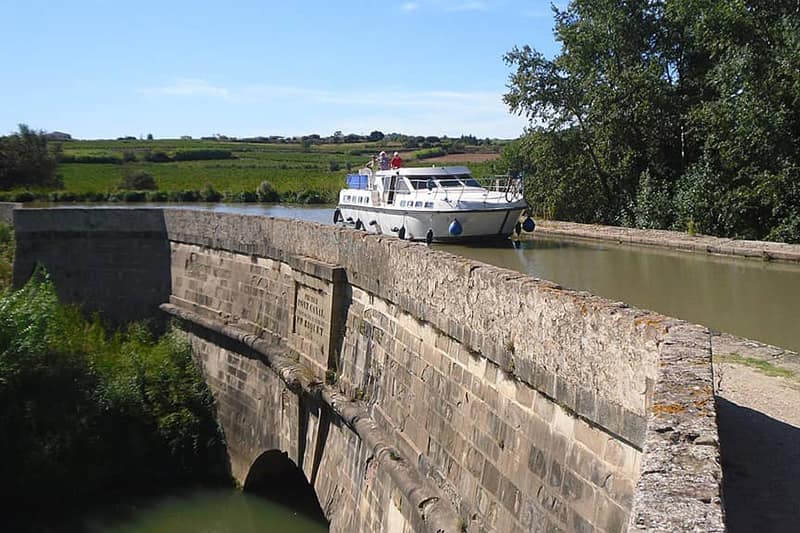From Neptune’s Staircase on Scotland’s Caledonian Canal to Gustav Eiffel’s Pont Canal de Briare in Western Burgundy – we’ve listed our top 10 extraordinary feats of engineering on Europe’s inland waterways…
10 Extraordinary Feats of Engineering on Europe’s Inland Waterways

1. The Seven-rise Lock Staircase of Fonserannes
A masterpiece of engineering the seven-rise lock staircase of Fonserannes is the largest rise on the Canal du Midi. Oval in shape, and flanked by steps, initially eight locks were built to link the River Orb at Béziers with the canal. The construction of the aqueduct over the river Orb in 1858 contributed to the modification of the second lock, whose left wall was pierced to make room for the new connection. Following the introduction of the Freyconet gauge which standardised the size of locks across France at 38 metres, solutions were sought to move larger barges along the Canal du Midi with its 30-metre locks. Consequently, a water-slope, based on that at Montech on the Canal du Garonne, was constructed at Fonserannes to allow 38 metre barges to circumnavigate the locks. The project was abandoned in the 1980s, and today remains derelict at the lock-side.

2. The Arzviller Boat Lift, Alsace & Lorraine
Located on the Canal du Marne au Rhin, at the point between the Vosges Mountains and the Zom Valley on the waterway which leads to the Rhine and Strasbourg, the Arzviller boat lift was built to bypass a flight of 17 locks that would take boats almost a day just to climb or descend. To do this, it was necessary to create a new downstream reach and a long upstream reach that was cut into the sandstone with explosives, approximately 1 million tonnes of spoil was removed in the process. The boat lift, between these two new cuts, carries our hotel barge Panache 45 metres up an inclined plane without the slightest tremor being felt and within five minutes it passes from the upstream to the downstream gates.
Cruise Alsace & Lorraine aboard: Panache | La Nouvelle Etoile

3. The Briare Aqueduct, Western Burgundy
When it was necessary to define how the canal would cross the river Loire, the engineer Lejeune favoured a river crossing, which required a lock on each bank and the creation of a permanent channel in the riverbed. However, this was soon deemed unsatisfactory, since the Loire is incredibly temperamental – flooding in the winter and drying in the summer. Plans for a canal bridge were therefore drawn up to remedy the problem. Its chief engineers Léonce-Abel Mazoyer and Charles Sigault initially drew up the plans, and together created a structure which had the advantage of being light enough to be supported by arches and well-spaced pillars, which in turn ensured that the Loire would not have any problems with the flow of water during times of flood. Although the Briare Aqueduct, or the Pont Canal de Briare, was not the first of its kind, the choice of material to construct the bridge was – especially given its length of 662m. The metal trough was the work of Daydé et Pillé, and, despite a persistent legend, the company of Gustave Eiffel only built the reinforced concrete pillars. Obelisk-shaped monuments flanked by chimeras on rostrums adorn each end, where the names of the towns and linked to the Canal Latéral à la Loire can also be seen. The canal-bridge was opened to navigation in 1896.
Cruise Western Burgundy aboard: Renaissance

4. The Clachnaharry Swing Bridge, Scottish Highlands
The Clachnaharry Swing Bridge was built in 1909 for the Highland Railway, replacing the original bridge of 1886. A steel-bowed plate-girder swing bridge 37.5m (126ft) long crosses the Caledonian Canal, and swings to one side to allow boats to pass into or out of the adjacent lock. One of the last remaining hand operated swing bridges left in Britain, it is controlled by both railway and canal signals. The Duke of Sutherland, a director of the Highland Railway, was a keen railway enthusiast and often drove his own small tank engine along the line. The bridge was almost the cause of an accident involving the Duke when he just managed to stop his locomotive by the railway signal, which indicated that the bridge was open. He was later remonstrated for dangerous driving by the stationmaster of Clachnaharry station, who was also one of his own employees. The Highland Railway Line opened in 1862, and is still in use to this day.
Cruise the Scottish Highlands aboard: Spirit of Scotland | Scottish Highlander
5. Needle Dams on the Canal du Nivernais
Beneath the bridge of Cours-Barrée on the Canal du Nivernais, is one of the last needle dams on the River Yonne. Invented in 1834 by the French engineer Antoine Poirée, needle dams were designed to maintain the level or flow of a river using thin “needles” or posts of wood. The needles are leant against a solid frame and are not intended to be water-tight. Individual needles can be added or removed by hand to constrict the flow of the river, forming a sluice. The Canal du Nivernais features several needle dams, such as those at Cours Barrée, Merry-sur-Yonne and Biches, that have resisted to any sort of modernisation during their 170 years of existence.
Cruise the Canal du Nivernais aboard: L’Art de Vivre

6.The Pont de Répudre on the Canal du Midi
The oldest navigable canal bridge in the world, the Pont de Répudre was initially the only such aqueduct built on the Canal du Midi, before two others were constructed under plans initiated by Vauban. A commemorative plaque affixed by Pierre-Paul Riquet’s descendants on the south side of the bridge, however, reminds us that he was the engineer responsible. The bridge is not only a feat of engineering for being the first, but also that it happens to turn with a bend in the canal, too!
7. Neptune’s Staircase on the Caledonian Canal
Set in the shadow of Ben Nevis, Britain’s tallest mountain, Neptune’s Staircase is a dramatic flight of eight locks on the Caledonian Canal. Situated in the picturesque village of Banavie, just north of Fort William, this amazing feat of engineering raises the canal by 19m (62ft) over a quarter of a mile of continuous masonry and it takes around 90 minutes for a boat to travel up or down the locks. Built by Thomas Telford between 1803 and 1822, it is the longest staircase lock flight in Scotland. Not only is this remarkable feat of engineering a good spot to enjoy watching the boats as they travel up and down the lock flight, but it is also ideal for train spotters, as the West Highland Line crosses the canal at the bottom of the locks. A number of historic buildings, including some former lock keepers’ cottages, also line the banks.
Cruise the Scottish Highlands aboard: Scottish Highlander | Spirit of Scotland
8. The Tunnel de Savoyeux on the Burgundy Canal
The route at the summit of the Burgundy Canal was, for a long time, a subject of much debate. As early as 1724, the engineer Joseph Abille recommended a passage through the threshold at Pouilly-en-Auxois. Over the following years and decades, other engineers discussed the possibility of a tunnel under the town of Sombernon so as to directly access the Brenne Valley, however in 1823 the engineer Charles Forey, who had previously worked on the Canal du Centre, decided definitively to tunnel through the hills under the market town of Pouilly-en-Auxois to the tiny hamlet of Escommes. The Tunnel de Savoyeux, a little more than 3km long, was built with the aid of 32 shafts to expel the spoil, and which later were used for its ventilation and lighting. Construction of the tunnel was completed in 1832, finally allowing the passage of barges across Burgundy and for cargo to be transported from the north to the south of France.
Cruise the Burgundy Canal aboard: La Belle Epoque | L’Impressionniste
9. The Aqueduct at Brienon-sur-Armançon
The small, four-arched aqueduct with brick foundations at Brienon-sur-Armançon allows barges on the Burgundy Canal to cross the river Créanton. However, what is all the more extraordinary is that the aqueduct not only supports the canal, but also a lock! That its lock-walls have remained intact, is nothing short of remarkable. The lock is only one of two built by the engineer Ubriot Montfeu, and those who navigate through it will appreciate the elegance of the masonry used. The lock-house, which is more than 200 years old, continues to see boats pass by.
Cruise the Burgundy Canal aboard: L’Impressionniste | La Belle Epoque
10. The Four Locks on the Canal du Centre
As soon as the Canal du Centre reaches the watershed in the direction of Châlon-sur-Saone, it meets a steep slope, that was initially climbed by seven locks that were separated by short pounds, allowing the upstream and downstream boats to pass each other. At the end of the 19th century, when the canal was upgraded to the Freycinet gauge, the route of the canal was slightly modified and the number of locks reduced to four. The fall of each was increased to about 5 metres which made them, for a short time, the deepest locks in France. One of the old locks, thanks to the straightening of the canal’s course, was not destroyed and today forms part of a museum at the canalside.
Cruise the Canal du Centre aboard: Finesse
Discover Europe's Engineering Feats with European Waterways
You can experience many of the feats of engineering mentioned above on a European Waterways luxury barge cruise. To find out more about luxury hotel barging, why not order a complimentary copy of our brochure or speak with a member of our Cruise Team via our Contact Form.
You can experience many of the above locks on a European Waterways luxury barge cruise. To find out more, order a complimentary copy of our brochure or speak with a member of our Cruise Team via our Contact Form.
 English
English
 Spanish
Spanish French
French German
German Norwegian
Norwegian Portuguese
Portuguese Swedish
Swedish Italian
Italian Russian
Russian Simplified Chinese
Simplified Chinese Japanese
Japanese





